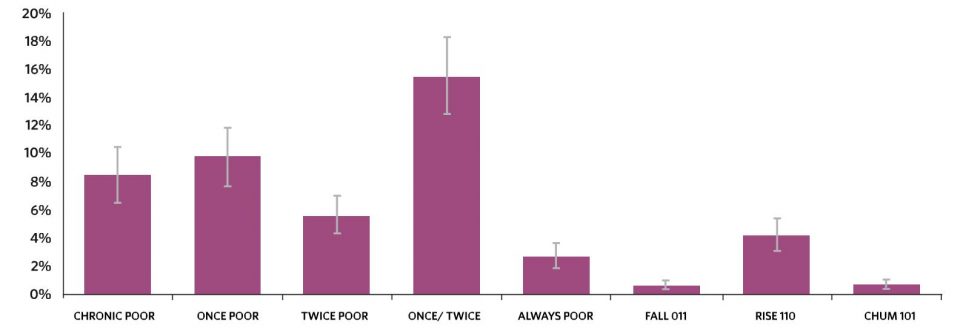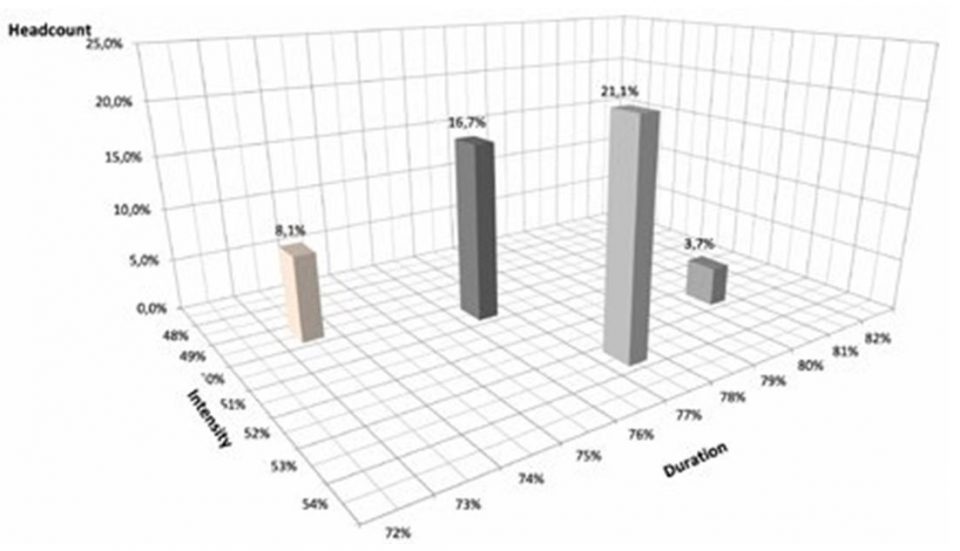Measuring Chronic Multidimensional Poverty
By:
Mauricio Apablaza, PhD, Director de Investigación, Facultad de Gobierno, UDD.
Sabina Alkire, PhD, Director, Oxford Poverty & Human Development Initiative, University of Oxford
Satya Chakravarty, PhD, Honorary Visiting Professor, Indian Statistical Institute
GastonYalonetzky, PhD Lecturer in Economics at the Leeds University Business School, University of Leeds
This paper adopts a new approach to the measurement of chronic multidimensional poverty. It relies on the counting approach of Alkire and Foster (2011) for the measurement of multidimensional poverty in individual time periods, and then on the duration approach of Foster (2009) for the measurement of multidimensional poverty persistence across time. The proposed indices are sensitive both to (i) the share of dimensions in which people are deprived and (ii) the duration of their multidimensional poverty experience. A related set of indices is proposed to measure transient poverty. An empirical illustration is provided for Chile between 1996 and 2006.
Poverty is a multidimensional phenomenon (Sen 1976). However, poverty has traditionally been understood as one-dimensional and measured only by insufficient income to achieve a decent life. Only recently has specialized literature tried to systematically measure poverty conditions in a multidimensional framework.
The work of Alkire and Foster (2011) established the basis of modern indicators of multidimensional poverty based on a capacity approach, which expands the understanding of well-being by incorporating the “capacity” of individuals to do and be as based on their personal freedom. Poverty in this context is the absence of the most basic capabilities that contribute to a reasonable life (Hick, 2012). The axiomatic methodology proposed by Alkire and Foster (AF) is not the first measurement of multidimensional poverty; however, its relevance enabled the expansion of the concept and its application in a number of countries, including Chile. Addi- tionally, the axiomatization of the technique demonstrates compliance with principles that help evaluate the robustness of the indicator.
The AF methodology expands the one-dimensional poverty indicators proposed by Foster, Greer, and Thorbecke (1984) incorporating additional dimensions and establishing a second cut to identify poverty. In simple terms, a series of relevant dimensions are defined given the analyzed context. In each of these, a cut-off line is determined that identifies whether an individual or household is deprived in said dimension in a manner similar to the measurement of one-dimensional povert. The sum of these deprivations allows the joint distribution of deprivations to be evaluated and to identify those who are in a situation of greater or lesser poverty. The methodology identifies those who are poor multi-dimensionally to the extent that they have a certain number of private dimensions. AF proposes three key indicators: (1) counting index or percentage of people in poverty (H); (2) the intensity or average percentage of private dimensions among the poor (A); and, (3) the count index adjusted for said intensity (M0).
The approach presented by Alkire and Foster (2011) analyzes the levels of multidimensional poverty using only the first table in the following figure. In this case, each of the rows corresponds to an individual, and each of the columns fitting the dimension of being private is assigned a value equal to 1. Note that the first individual is deprived of education, income, and health. The second individual is deprived of income and health; and, the last one, only of income. Considering those who have more than one private dimension as poor, Alkire and Foster would suggest that individuals 1 and 2 are poor. Therefore, the counting incidence would be equal to 2/3, the intensity 5/6 and the global index (M0) 5/9.

The main objective of research was to incorporate the time factor (t) in a methodology such as that proposed by Alkire and Foster. That is, the article discusses how to evaluate multidimensional poverty when there is information from individuals in previous periods. First, indicators are proposed to assess changes in poverty levels in repeated surveys over time, thus using longitudinal data. As an illustration of the methodology, the case of Chile 1996 – 2006 is explained.
The first approach is mechanical. The percentage changes in the poverty index (M0) can be broken down into (1) the percentage changes in the percentage of poor people and (2) the intensity of poverty. To this is added an extra component that is the product of both. Additional decompositions of each of these factors are also proposed. In the case of longitudinal data, the analysis is more interesting because it includes the generation of stories of individuals. In this case, changes in poverty rates are theoretically related to transition probabilities, i.e., to what extent the percentage change in the multidimensional poverty indicator is associated with households that ceased to be poor and households that became poor. Moreover, the proposed methodology explores the incidence of the transitions of each of the deprivations in the aggregate indicators. Additionally, there is a decomposition of change based on a dominance analysis between two subgroups.
The following figure shows the poverty transitions for Chile between 1996 and 2006. In the first year, 13.93% of the population was identified as poor, of this 7.04 % were still poor in 2001, and 2.77% remained poor in 2006. On the other hand, 81.68% of the population never ranked as poor.

At last, an axiomatic indicator was developed to analyze chronic multidimensional poverty. That is, it generates a synthetic measure of the transitions of individuals over time by identifying those who are permanently in one or another condition, as well as those who were able either to overcome or enter into poverty. For this purpose, axioms present in the literature were used, and new axioms were proposed according to this newliterature.Thefollowingfigureshowsthe incidence results of each of the subgroups considered.

Finally, the measure not only classifies individuals but also their poverty level indicators decomposing by dimension and subgroup. The following figure shows this result for four regions of Chile represented by the incidence and intensity of poverty, and also by the average duration of the condition over time. In this case, the metropolitan region has the lowest incidence of chronic multidimensional poverty but at the same time has the longest duration. That is, the poor individuals are proportionately a small number, but they remain in poverty more periods of time than similar population in other regions.

The proposed indices are sensitive both to the share of dimensions in which people are deprived and the duration of their multidimensional poverty experience.
The extensions of this research to public policy are direct and important. First, a multidimensional approach enables a more precise characterization of the population in need and their specific needs. Second, the possibility of evaluating transitions facilitates the identification of relevant factors that permit an individual to enter or exit poverty. These relevant factors should be the main consideration of public policy. Third, a multidimensional measure recognized the poorest of the poor, that is, those individuals who not only do not reach a reasonable standard of living but live in a situation that becomes permanent.
